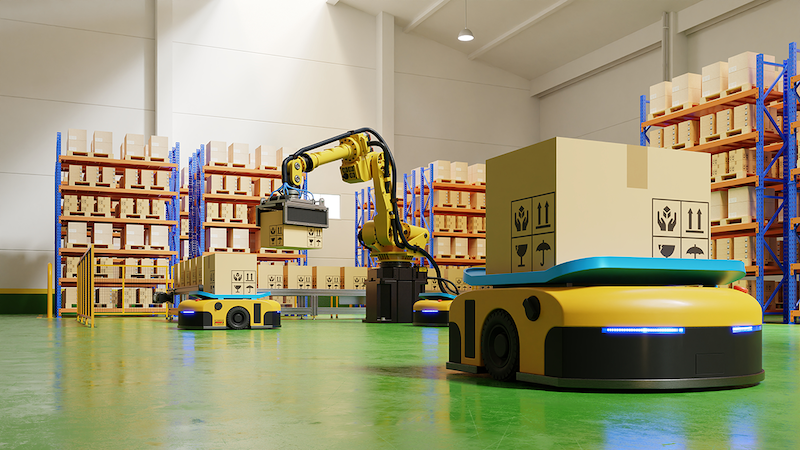By Luca Bandiera, business development AGV manager, ZAPI GROUP
Labor optimization is increasingly relying on automated guided vehicles (AGVs) and automated mobile robots (AMRs). Offloading material handling tasks allows leaders to reallocate workers toward higher-value, more complex processes.
However, for OEMs and machine engineers, challenges remain, particularly in powertrain design. As AGVs and AMRs advance in capability and complexity, so must the powertrains that propel them.
Achieving sustainable next-generation drivetrains requires OEMs to choose between fully integrated powertrain systems and modular, component-based ones. This choice impacts every link in the handling chain, from supplier logistics to final installation.
At a machine level, the degree to which a powertrain is integrated (or modular) directly influences energy efficiency, uptime, maintainability, and ultimately, the AGV’s total cost of ownership.
How do AGV powertrains differ from basic electric drive systems?
Distinctions between basic electric drive systems and advanced AGV powertrains lie in the degree of system intelligence and energy optimization.
Conventional electric drive systems are limited in scope, typically only offering:
- Simple motor control
- Fixed performance parameters
- Reactive maintenance
- Standalone operation
Advanced AGV powertrains are engineered as intelligently connected systems. Key features include:
- Integrated motor controllers pre-calibrated for efficiency and load responsiveness
- Regenerative braking systems for improved energy recovery
- Adaptable performance based on real-time battery data
- Predictive maintenance capabilities with remote diagnostics
- Vehicle connectivity and localization for smart fleet management
The market favors solutions where powertrain installation delivers immediate benefits, minimizing commissioning time and maximizing performance.
Trade show trends and supplier feedback suggest a preference for handling component integration at the supplier level rather than leaving it to end users.
The critical role of system integration in modern AGV powertrains
As customers increasingly prioritize performance and systems grow more interconnected, integrated architecture becomes more critical than the impact of individual components.
Rather than singular motors or batteries, efficiency and sustainability require hardware and software solutions that work together.
An integrated design approach unlocks new possibilities in AGV equipment:
- Intelligent energy management: In many AGVs, the battery accounts for up to 30 percent of total system value. Preserving this investment via battery management systems and intelligent charging management enhances operational efficiency and reduces battery degradation over time.
- Navigation and motion control: Powertrains with native integration into navigation systems offer low-latency response, accurate feedback, and embedded safety monitoring. This integration simplifies vehicle architecture while improving control and reliability.
- Fleet-level optimizations: Real-time data from intelligent powertrains enables predictive maintenance, adaptive task scheduling, and centralized fleet orchestration. Visualized performance metrics across the fleet inform operational decisions and reduce downtime.
- Safety and reliability integrations: Reliable autonomous operation depends on embedded safety. Drives equipped with certified encoders and native functions such as Safe Torque Off and Safe Stop 1 reduce the need for external components, lower integration complexity, and support compliance without requiring structural redesign.
Modularity remains essential as integration deepens, especially from a greater architectural standpoint. Interchangeable architectures, as opposed to interchangeable components, will ultimately serve as the catalyst for efficient deployment across AGV platforms.
One day, the market will likely offer a broader portfolio of integrated powertrains, covering a wider range of vehicle classes and performance envelopes.
This evolution will enable OEMs to match application requirements more precisely, balancing efficiency, safety, and scalability within a unified system design.
Market applications and industry transformation
All industrial sectors stand to benefit from adopting advanced powertrain solutions. Increasing system intelligence simplifies the end-user experience by enhancing efficiency, safety, and ease of integration.
As the market continues to favor integrated solutions, OEMs who balance smart powertrain integration with flexible architectures are better positioned to capture a significant market share.
The progress of artificial intelligence solutions promises smart, embedded solutions in next-generation AGVs. Already, many end users are making significant investments in this direction.
OEMs and system designers who prepare for these changes can establish themselves as strategic partners ready to harness the next generation of autonomous mobility.

About the author: Luca Bandiera is the business development AGV manager at ZAPI GROUP. His technical background – an electronics diploma and a degree in electronic engineering – combined with previous experience in R&D and sales, has given him a comprehensive view of both product and market.

